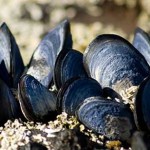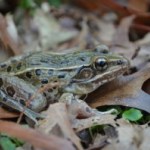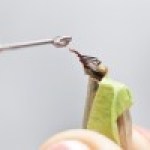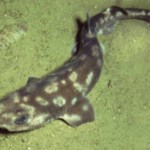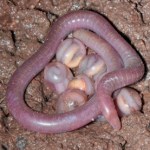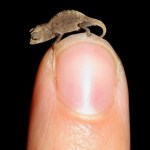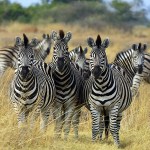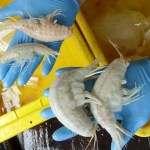
New research shows how mussels find the perfect match. For mussels, fertilization occurs between eggs and sperm that have been released into the water. Up until now, it seemed the pairings were random limiting the ability to choose mates and diminishing the chance for successful fertilization due to genetic mismatches. However, recent research shows that the eggs actually release chemicals to attract the most compatible sperm.
Since mussels are able to stick to just about any surface, including teflon (image below), other researchers are exploring mussel proteins for creating bio-inspired…
New research conducted by Dr. Gary Beauchamp from the Monell Chemical Sciences Center in Philadelphia has shown that seven of twelve species of carnivorous mammals tested lack taste receptors for sweets. According to the article, Dr. Beachamp and his colleagues identified mutations in the mammalian taste receptor for sweets (Tas1r2/Tas1r3) in animals from the Pinnipedia order (sea lions, fur seals and Pacific harbor seals), bottlenose dolphins, Asian small-clawed otters, Spotted hyenas, fossa (member of the mongoose family), and cat-like banded linsangs. In contrast, normal sweet receptors…
Thanks to everyone who sent in their feedback about last week's post on Top Reasons for Loving Comparative Physiology. It inspired another reader to send along this humorous photo entitled, "Lining Up to Hear A Talk About Comparative Physiology," alleged to have been taken at last year's EB meeting. Not exactly hard science, but in the spirit of rewarding people for creativity and humor, Mr. N will receive a "What's New in Comparative Physiology?" t-shirt! Have an idea about comparative physiology? Tell us, and get your chance to win. Contest rules are here.
Image Source: UA News, Brian Curry, Rutgers.
It is easy to get lost in a crowd, especially in an area as densely packed as New York. Scientists from UCLA, Rutgers University, UC Davis and The University of Alabama have discovered a new species of frog in just that region! The frogs were found in the ponds and marshes of Staten Island, mainland New York and New Jersey although there is evidence that they were recently common on Long Island as well. Jeremy Feinberg is the ecologist responsible for discovering what he thought were leopard frogs with a very strange call. Despite looking an…
Thanks to all those who have been sending their ideas about why they like comparative physiology. Two non-science students sent me a list this week with the reasons they think comparative physiology is interesting. Do they deserve a Dolittle t-shirt? At least for "originality"?
Animals and their adaptations (or maladaptations in some cases) offer insight into the human condition.
Every day is casual day for a comparative physiologist's subjects.
Birds, sharks, horses, insects - all animals are "natural" teachers.
Non-human vertebrates may hold the answers to questions humans haven't even…
Image Source: The Scientist, Robert Lamberts NZPFR.
Dr. Stephen Chambers from the University of Otago, New Zealand successfully isolated volatile chemicals produced by cultured tuberculosis bacteria (Mycobacterium tuberculosis). Testing the breath of infected humans, he was also able to identify nicotinic acid, which was one of the volatile chemicals released by the cultured bacteria (as methyl nicotinate). As it turns out, methyl nicotinate is a chemical attractant for insects. This led Dr. Chambers to team up with Dr. Max Suckling at the New Zealand Institute for Plant and Food Research.…
Image Credit: California Academy of Sciences
At just over 1 foot long, this newly discovered species of shark (Bythaelurus giddingsi) is not likely to be featured in a remake of "Jaws". The sharks were seen at depths over 1000 feet off the coast of the Galapagos Islands and belong to the catshark family. Seven specimens were collected and studied at the California Academy of Sciences and a description of their morphology and similarities with other species of catsharks is presented in a recent issue of Zootaxa.
"The discovery of a new shark species is always interesting, particularly at this…
Image source: Burlington Equine Veterinary Services, LLC.
Talk about comparative physiology! Some older horses develop a condition called equine heaves, which is similar to asthma in humans. Horses that live in more humid environments that promote mold growth are more prone to the disorder than horses that have lived in dry environments. It is also common in stabled horses fed hay as a result of prolonged exposure to dust particles released while eating. Similar to humans with asthma, there seems to be a genetic link to the disorder in horses.
The treatment of horses with heaves is similar…
If you have not yet had a chance to see this viral video from CBS News of dolphins swimming en masse, here it is! I have seen large pods of dolphins gather around the fishing vessel when deep sea fishing, presumably hoping for a reject from one of the fisherman. I have also seen them following cruise ships and other ocean vessels, but I have never witnessed that large of a group. When pods of dolphins come together, it is called a herd or aggregation, which sounds less exciting than what the media have been calling it: a "stampede". This particular aggregation consisted of ~2000 dolphins…
Image: Proceedings of the Royal Society B
Dr. Biju and colleagues at the University of Delhi have discovered a new family of limbless caecilian amphibians (Gymnophiona) in northern India. Although these soil-dwelling animals look an awful lot like earthworms, genetic testing and comparative analyses of their cranial anatomy show that they are in fact an ancient lineage of amphibians that first appeared ~140 million years ago (early Cretaceous). Unfortunately, they are threatened by human expansion.
The San Diego Zoo has a neat website with more information on this order of amphibian.
If…
I am getting very excited about the upcoming Experimental Biology conference especially since this year marks the 125th anniversary of The American Physiological Society for which there are many planned celebrations. Not to mention, the programming for comparative physiology at this year's meeting is really exciting:
Comparative and Evolutionary Physiology Section
Distinguished Lecture:
Tuesday, April 24, 2012, 8:00-10:00 AM
James Hicks
August Krogh Distinguished Lectureship of the APS Comparative and Evolutionary Physiology Section
Symposia:
Monday, April 23, 2012, 3:30-5:30 PM
Nina…
As it turns out, researchers have discovered that fruit flies will actually drink alcohol created from rotting fruits to kill off parasitic wasp larvae.
Source:
YouTube Video: Emory University
Milan NF, Kacsoh BZ, Schlenke TA. Alcohol Consumption as Self-Medication against Blood-Borne Parasites in the Fruit Fly. Current Biology Feb 16, 2012.
Image Source: PLoS One
A new tiny species of chameleon (Brookesia micra) was recently discovered in Madagascar. The scientists who discovered the animal speculate that it is likely at the lower limit of size for a vertebrate with complex eyes. Shown in the image above is a juvenile.
At a little over half an inch, the chameleon loses out on being considered the world's tiniest vertebrate. This record is currently held by a recently discovered teeny frog (equally adorable at an average length of 0.3 inches) that was found in a pile of leaves in Papua New Guinea. You can see a photo of the…
Russian scientists succeeded in growing a plant from 30,000 year-old (late Pleistocene) fruit tissue! The fruit tissue was found in an ancient squirrel's burrow frozen in the permafrost. You are probably thinking, what in the world does this have to do with animals or physiology? I'll tell you. There is also talk of the possibility of resurrecting ancient animals using tissues cryo-preserved in the permafrost (albeit a long way off from resurrecting plants). I find myself wondering if they ever watched the movie Jurassic Park...
What are your thoughts about the possibility of "resurrecting"…
Image Source: Newsweek (DLILLC-Corbis)
I just came across this neat synopsis from Newsweek about obesity in cats and dogs that is based on information from the Association for Pet Obesity Prevention. I was really surprised to learn that 54% of pet cats and dogs are considered overweight or obese. What was really interesting though, was that only 8-9% of owners would call their own animals obese. I have to admit, having a Garfield-like cat of my own, that they are easier to take care of when they are what I like to call "cuddly". After he lost weight, he had so much more energy to get into…
A new study supports the hypothesis that noises from maritime traffic actually do induce stress in whales. For a time after the attack of the Twin Towers in New York City, fewer ships traveled in the area and researchers noticed that the stress levels of whales dropped dramatically. In an article from Discovery News, it was noted that some of the ocean vessels emit the same low-frequency wavelengths as those used by baleen whales to communicate. To adapt, some animals have changed the frequency or volume of their songs.
You might be wondering how in the world they measured stress in whales?…
As many people know, snakes do not need to eat very often. What I just learned from a recent article in Science magazine is that for Burmese pythons, many organs actually increase in mass after eating a large meal and blood levels of fatty acids are substantially elevated. Riquelme et al, were interested in what happens to the hearts, specifically. What they found was that the heart cells increased in size within 3 days after the snakes ate a meal (see figure). In addition, the python hearts developed an increased ability to take up and metabolize fatty acids but had also developed protective…
Image: Wikimedia Commons
The most recent issue of The Journal of Experimental Biology provides insight into why zebras have evolved stripes. Using a horse model, researchers have shown that horseflies find zebra stripes less attractive than homogeneous colors. It turns out that horseflies are attracted to linearly polarized light whereas the pattern of wide black and white stripes on zebras reflect different polarizations making them less attractive to the biting insects.
Too bad mosquitoes are not attracted to light patterns. I would wear zebra-striped pajamas all summer long if they were…
The image above shows a mummified ibis from ancient Egypt that was packed with snails after death. Other mummified ibises were found packed full of grains or small fish. These findings are the first evidence that the ancient Egyptians provided these birds with food for the afterlife. To read more and see the amazing images, visit National Geographic's Daily News.
Source:
National Geographic Daily News
Image from the Daily News: Andrew Wade and Yale Peabody Museum (item ANT.006924.004)
Check out this new species of shrimp-like amphipods that was discovered in an ocean trench off the coast of New Zealand! The biggest one found was 11 inches long. Yum...
Image: National Geographic
While reading this article, I could not resist the enticing advertisement for an even larger shrimp-like creature (over 3 feet!) that lived in prehistoric times. You can read more about this jumbo, jumbo shrimp here. They even have an artist's rendition of what it may have looked like.
Source for story of extant shrimp:
National Geographic
